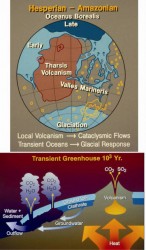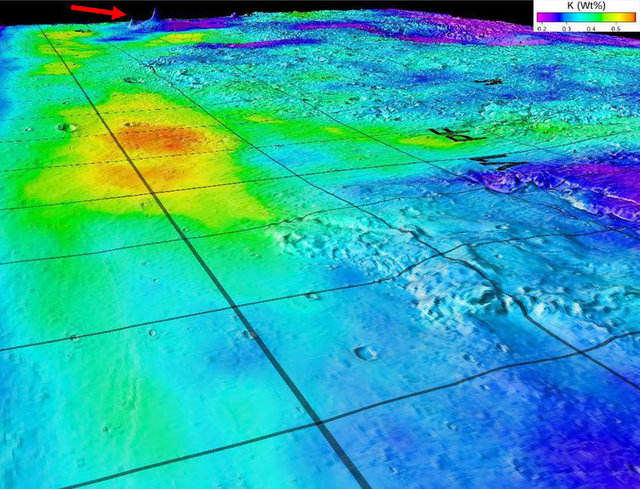[/caption]
Data from the Mars Odyssey orbiter’s Gamma Ray Spectrometer provides new evidence for the controversial idea that oceans once covered about a third of ancient Mars. Spacecraft images going back to Mariner 9 in the early 1970s and the Viking orbiters and landers later in the 1970s up to the current orbiters and rovers have showed widespread evidence for a watery past for Mars. About 20 years ago, several studies sparked a scientific debate on the possible existence of ancient Martian oceans marked by visible shorelines. Images and topographic maps provide evidence for two different oceans in one area, perhaps occuring at different times in Mars history, a larger one at an earlier time, and a smaller once existing later. Odyssey’s GRS can detect subsurface elements, and new data confirms the right combination of elements for two ancient shorelines.
The spectrometer has the unique ability to detect elements buried as much as 1/3 meter, or 13 inches, below the surface by the gamma rays they emit. That capability led to GRS’ 2002 discovery of water-ice near the surface near Mars arctic region, leading to the decision for the Phoenix landing site.
“Our investigation posed the question, ‘Might we see a greater concentration of these elements within the ancient shorelines because water and rock containing the elements moved from the highlands to the lowlands, where they eventually ponded as large water bodies?'” said University of Arizona planetary geologist James M. Dohm, who led the international investigation. “We compared Gamma Ray Spectrometer data on potassium, thorium and iron above and below a shoreline believed to mark an ancient ocean that covered a third of Mars’ surface, and an inner shoreline believed to mark a younger, smaller ocean.”
Results suggest that past watery conditions likely leached, transported and concentrated such elements as potassium, thorium and iron, Dohm said. “The regions below and above the two shoreline boundaries are like cookie cutouts that can be compared to the regions above the boundaries, as well as the total region.”
The younger, inner shoreline is evidence that an ocean about 10 times the size of the Mediterranean Sea, or about the size of North America, existed on the northern plains of Mars a few billion years ago. The larger, more ancient shoreline that covered a third of Mars held an ocean about 20 times the size of the Mediterranean, the researchers estimate.

The potassium-thorium-iron enriched areas occur below the older and younger paleo-ocean boundaries with respect to the entire region, they said. The scientists used data from Mars Global Surveyor’s laser altimeter for topographic maps of the regions in their study.
Scientists studying spacecraft images have a hard time confirming “shoreline” landforms, the researchers said, because Mars shorelines would look different from Earth’s shorelines. Earth’s coastal shorelines are largely a direct result of powerful tides caused by gravitational interaction between Earth and the moon, but Mars lacks a sizable moon. Another difference is that lakes or seas on Mars could have formed largely from giant debris flows and liquefied sediments. Still another difference is that Mars oceans may have been ice-covered, which would prevent wave action.
“The GRS adds key information to the long-standing oceans-on-Mars controversy,” Dohm said. “But the debate is likely to continue well into the future, perhaps even when scientists can finally walk the Martian surface with instruments in hand, with a network of smarter spaceborne, airborne and ground-based robotic systems in their midst.”
Source: U of Arizona


Something just occurred to me about Mars’s lack of a large moon, because of which there would have been no appreciable tides on those ancient Martian seas. Some believe that Mars once had a much thicker atmosphere than it has now, and a giant impact stripped it of most of that atmosphere and, perhaps, its large oceans. What if Mars once had a fairly large moon, a moon which was destroyed or hurled away from Mars by such an impact? Is there any evidence for tidal forces on ancient Mars that could only have arisen due to the influence of a significantly large Martian moon? If we ever turn up such evidence, it would drastically alter our models of the evolution of the Martian atmosphere, hydrosphere, lithosphere, and any biosphere that primordial Mars might have had.
Mr Obvious – I’ve heard that same statement before that atmosphere’s have to do with size and gravity. My question is then what about Titan it’s small and holds its own atmosphere.
This proves that earth like planets are common. In our own solar system we have the Earth, Mars, Venus probably was at some time, Europa, Titan and maybe even Ganymede.
OSCAR common in what way? There are some similarities, yet there are many many differences as well, especially if you only look at them externally. Internally they are quite different, and not just because they are located in 3 different areas of the solar system.
Lack of atmosphere on Mars is generally believed to be due to its mass… or lack there of. There isn’t enough gravity to hold a large/deep atmosphere.
It is possible Mars once held a larger moon, but as of yet, there is no evidence.
Isn’t the lack of atmosphere on Mars due to it’s lack of a magnetosphere?
Escape velocity depends on mass M and radius r:
ve = sqrt(2GM/r)
The average gas velocity depends on temperature T, and molecular weight of the atom/molecule.
v = sqrt(kT/m).
Lighter molecules escape quickly, like H2; heavier ones take longer.
Although most of the escaping molecules are at the high velocity tail of the distribution, not at the average.
Far from Sun, it is easier to retain an atmosphere.
Are we still debating Mars oceans?
I thought we found layered ( sedimentary ) rocks ?
What would happen if we introduced lychens (however it is spelled) into the martian soil then grasses to begin a small atmosphere?
Mr Obivious
These worlds are earthlike because they share similarities and have or once had varied geology which we can relate to here on earth. With this amount of variety in our own solar system with at least three ocean type worlds Europa, Titan, The Earth not to mention the rest, all which are likely to have some sort lifeforms. Evidence of methane on Mars, Titan, outer solar system full of methane and water. Lifeforms found on earth in similar exterme enviroments. All of this in our solar system. I call that pretty good odds. If you don’t believe that we will find life on Mars and Titan, then print your name and declare it , because you will be proved wrong.
Yes you have been proved wrong. It is not wishful thinking, just look at the evidence, Humans would never have left their caves if they follwed your approach to science.Trying to correct other peoples writing is also extremely ignorant and rude, especially when you’re wrong and it has nothing to do with the subject..
Here is an interesting article that shows tantalizing evidence that the original heavy atmosphere of Mars was lost through a process in which sections of the magnetic field of Mars connect with the Solar Wind’s magnetic field. Then, a piece of magnetic field gets pinched off and carries off a bubble of atmosphere.
http://science.nasa.gov/headlines/y2008/21nov_plasmoids.htm?list1043461